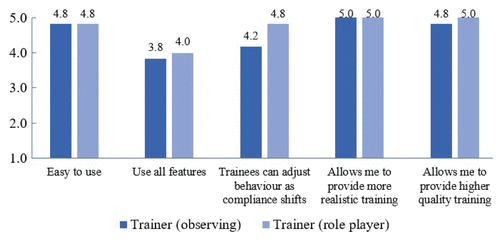
FIGURE 1 Ease of SV training and its contribution to realistic training
Genevieve Brook*, Miranda Elliott*, Craig Bennell*
ABSTRACT
Systemic changes, such as the deinstitutionalization of mental health care, have increased the likelihood that people with acute mental health symptoms encounter the police. Given this, greater attention is being paid to mental health training for police officers in Canada. The current study presents a preliminary evaluation of SimVoice, a training tool that was designed to enhance the realism of de-escalation training for officers who may encounter individuals experiencing auditory hallucinations. Survey responses from trainees and trainers who took part in SimVoice training suggest the training is viewed very positively. Trainers felt that SimVoice was easy to use and contributed to realistic training, and they unanimously indicated they will continue using SimVoice as a training tool. Trainers and trainees both felt that the training was useful for developing general and specific knowledge and skills that would help officers more effectively manage encounters with people in crisis. Survey respondents also identified limitations when using SimVoice, along with suggestions for improving its use in training.
Key Words: Mental health training, training evaluation, police training, auditory hallucinations, person in crisis, police
In June 2020, a man residing in Mississauga, Ontario, was killed by Canadian police officers during a mental health wellness check (Nasser, 2021). Ejaz Choudry was 62 years old and suffered from schizophrenia.1 After a call was made by Choudry’s family to a non-emergency line asking for someone to check on Choudry’s well-being, paramedics who arrived on the scene noticed he was carrying a knife and called for police reinforcement. Choudry’s family asked police to let them accompany officers into Choudry’s building, stating that their presence would make him more comfortable, as he feared officers in uniform. After failed negotiations with Choudry, officers, worried that Choudry was at risk of self-harm, entered Choudry’s unit through his balcony door and commanded in English that he drop his weapon (a language Choudry did not fully understand). After using both a conducted energy weapon and plastic projectiles on Choudry, an officer shot and killed him. Ontario’s Special Investigations Unit found the officers acted reasonably and ruled that there would be no criminal charges.
While cases like these are thankfully rare, such cases have led to calls for improvements to mental health training for Canadian police officers and to demands from some to divert funds away from the police to community-based support services for persons in crisis (PICs). A discussion of police defunding is beyond the scope of this article. Instead, the focus here is on the first issue—improving mental health training for police officers. While mental illness can present in many ways during police–citizen interactions, this study focuses on individuals experiencing auditory hallucinations who might encounter the police, and on training designed to equip police officers with the appropriate knowledge and skills, centred on de-escalation, to effectively engage with individuals experiencing such hallucinations. More specifically, a training tool called SimVoice (SV), which is described in more detail below, is evaluated to determine whether it can be used to enhance the quality of mental health training.
Such training, and the evaluation of it, is important, especially when one considers the degree to which persons with a mental illness (PMIs) are likely to interact with the police in Canada and the nature of these interactions. Factors such as the deinstitutionalization of mental health care have increased the likelihood that PMIs will encounter the police. Indeed, numerous studies have suggested that PMIs in Canada are more likely than those without mental illness to encounter the police (Boyce et al., 2015; Brink et al., 2011), and some studies highlight the potentially negative impacts of these interactions for PMIs, including the fact they can leave PMIs feeling traumatized and criminalized (Geller et al., 2014; Lamanna et al., 2018), and that they can (but do not always) result in higher levels of force by police when compared with interactions that do not involve PMIs (Kesic et al., 2013; Rossler & Terrill, 2017). Despite police officers now acting as frontline mental health responders, these officers often report not feeling adequately prepared for this role (Borum et al., 1998; Sellers et al., 2005), providing an additional reason why mental health training for officers needs to be delivered and evaluated.
Mental health training is regularly provided to Canadian police officers, although the quantity and quality of that training has varied over time and across jurisdictions (Coleman & Cotton, 2010). SimVoice (SV) was developed to improve the quality of interactions between police officers and PMIs. SimVoice is a free application that can be downloaded from the App Store. It is intended to be used by police trainers as part of their mental health training protocol. It was developed by a company in Winnipeg called SetCan. The application mimics auditory hallucinations that a PMI might experience during interactions with the police. Trainers listen to the hallucinations through headphones and are instructed to act in accordance with the hallucination, which encourages the role player to exhibit various levels of compliance with officer trainees (from cooperative to resistant). SimVoice has three primary objectives: (1) to create a barrier to communication so that trainees can learn to manage such interactions, (2) to guide trainees through various levels of subject compliance, and (3) to allow trainees to experience some of the challenges faced by members of the community who struggle with mental illness, and to develop empathy for the struggles faced by this group (SetCan, n.d.).
While it would have been optimal to conduct a study that compares the outcomes of training that does, or does not, include SV, logistical issues during the COVID-19 pandemic made this challenging. Instead, as a first step in the evaluation process, we collected survey data from trainers who have used SV in their training and trainees who have been involved in SV training. We were particularly interested in hearing from trainers about their use of SV as a training tool. We also wanted to capture views about the impact of SV on trainees and how this training might change their responses to PMIs in the future. Finally, we were interested in identifying limitations of SV, and ways in which the app could be improved.
Participants in this study were active-duty new recruits or police trainers from a Canadian police service. To be included in the study, trainees had to have taken part in their service’s SV training, and the trainers had to be qualified instructors who deliver this sort of training. In total, 38 members of the service indicated they would like to participate in the study, but only a subset of these members were retained for analysis given that some did not fully complete the surveys. We discuss the limitations associated with using a self-selected sample of survey completers below.
The final sample consisted of n = 27 trainees who acted as responding officers in the SV training. They had an average age of 26.6 years (standard deviation [SD] = 3.2) and 1.1 (SD = 1.0) years of service. This sample consisted of 8 female participants (29.6%), 15 male participants (55.6%), and 4 participants who did not indicate their gender (14.8%). Of the trainees, 23 indicated their rank as Constable, whereas 4 participants did not indicate their rank. Most participants (n = 23) indicated they had no previous specialized training on police-PMI interactions. The final sample also consisted of n = 23 trainees who participated as role players in SV training (i.e., they played the role of the PMI experiencing the auditory hallucinations). This group had an average age of 26.6 years (SD = 3.2) and 1.1 (SD = 1.0) years of service. There were 8 female participants (34.8%) and 15 male participants (65.2%). All participants indicated their rank as a Constable. Most participants (n = 19) indicated they had not completed previous specialized training on police-PMI interactions.
Both trainer surveys (observer trainers and role player trainers) were completed by the same 6 participants. The sample of trainers surveyed had a mean age of 40 years (SD = 4.8) and 14 (SD = 3.6) years of service. On average, the samples had 8.5 years of experience training police officers (SD = 5.5) and 2.4 years (SD = 1.8) of experience using SV. The sample of trainers consisted of 5 males (83.3%) and 1 female (16.7%). Five of the trainers held the rank of Constable (83.3%), while one trainer was a Sergeant (16.7%).
The evaluation sought, through online surveys, to analyze the usefulness of SV from four perspectives: (1) the instructor role player who was wearing SV during scenario-based training, (2) the instructor who was observing/evaluating trainees during scenario-based training where SV was used, (3) trainees who were given the opportunity to wear SV during scenario-based training, and (4) trainees who were actively participating as officers during scenario-based training where SV was used. The surveys consisted of Likert scales and open-ended questions. The surveys asked slightly different questions depending on the participant group, but questions generally focused on how SV contributes to mental health training, the observed impact of SV training on trainees, limitations of SV training, and ways to improve SV training. Demographic information was also collected.
Individuals who had participated in SV training, or who had provided SV training, were contacted by a member of the training team, who distributed a recruitment announcement. Those who were interested in participating contacted the second author by e-mail, who sent them the appropriate survey using a Qualtrics link. The surveys began with an informed consent form and ended with a debriefing form. Surveys took approximately 30 minutes each to complete, and responses from participants were anonymous. Surveys were completed throughout January and February 2022.
Many of the survey items asked trainees and trainers to reflect on SV training by rating various items using Likert scales. The examination of this quantitative data, which focused purely on mean ratings, is presented first. Following this, we present our analyses of qualitative responses.
One set of survey questions asked the trainers (observers, n = 6; role players, n = 6) to reflect on how easy SV was to use as a training tool and on the contributions that SV made to their service’s mental health training. Participants indicated their ratings on Likert scales ranging from 1 (Strongly Disagree) to 5 (Strongly Agree), and average scores were calculated based on the ratings. As illustrated in Figure 1, both groups of trainers rated SV very positively. All items received a score of at least 3.8 out of 5.
|
| ||
|
FIGURE 1 Ease of SV training and its contribution to realistic training | ||
Another set of survey questions assessed how useful SV was in developing general knowledge and skills among trainees that are relevant to interactions with PMIs. The participants indicated their ratings on Likert scales ranging from 1 (Strongly Disagree) to 5 (Strongly Agree). Average scores were calculated. As illustrated in Figure 2, both groups of trainees (participating, n = 26; role players, n = 22) rated the impact of SV training positively. All items received a score of at least 3.8 out of 5. As illustrated in Figure 3, both groups of trainers (observing, n = 6; role players, n = 6) also rated the impact of SV training positively. All items received a score of at least 4.7 out of 5.
|
| ||
|
FIGURE 2 Impact of SV training on general knowledge and skills—trainees. PMI = person with mental illness. | ||
|
| ||
|
FIGURE 3 Impact of SV training on general knowledge and skills—trainers. PMI = person with mental illness. | ||
The next set of survey questions assessed how useful SV was in developing specific knowledge and skills among trainees that are relevant to interactions with PMIs. The participants indicated their ratings on Likert scales ranging from 1 (Not at all Useful) to 4 (Extremely Useful). Average scores were calculated. As is illustrated in Figures 4a and 4b, both groups of trainees (participating, n = 26; role players, n = 23) generally felt that SV training was useful for developing specific knowledge and skills. Figures 4a and 4b also indicate that observing trainers (n = 6) felt that SV training was more useful than trainees for developing specific knowledge and skills.
|
| ||
|
FIGURE 4A Impact of SV training on specific knowledge and skills–trainees and trainers. PMI = person with mental illness; UoF = use of force. | ||
|
| ||
|
FIGURE 4B Impact of SV training on specific knowledge and skills—trainees and trainers. | ||
Finally, both groups of trainers (observing, n = 6; role-players, n = 6) were asked to provide their overall assessment of SV training by providing ratings on two items using Likert scales ranging from 1 (Strongly Disagree) to 5 (Strongly Agree). As illustrated in Figure 5, the overall assessment was very positive.
|
| ||
|
FIGURE 5 Overall assessment of SV training—trainers | ||
As mentioned previously, in addition to the rating data, trainees and trainers were also asked to respond to several open-ended questions. Content analysis was utilized to analyze these qualitative responses (Krippendorff, 2004). Specifically, we reviewed the qualitative responses provided by each survey respondent and generated content codes that emerged from their responses. We then counted how often the same content codes were endorsed by the survey respondents. We present this data in the sections below.
As illustrated in Table I, several limitations of SV training were highlighted. The most common limitation that was indicated by both groups of trainees (40.7% of the participating trainees and 47.8% of the role players) was that SV training does not generalize well to other situations they encounter as police officers (e.g., the scenarios they were exposed to did not include important elements of danger). As illustrated in Table II, analyses of responses from trainers also indicated several limitations of SV training. The most common limitation identified by both groups of trainers (66.7% of each group) was that the SV software did not always work (or work effectively) with the device that it was being used on.
TABLE I Main limitations of SV training—trainees
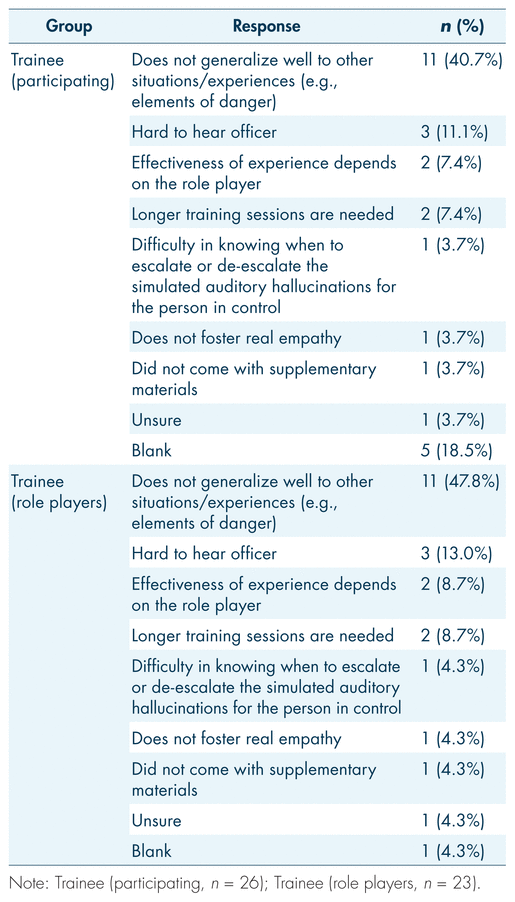
TABLE II Main limitations of SV training—trainers
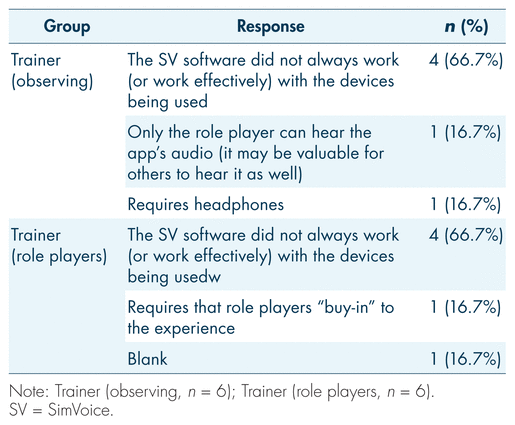
As illustrated in Table III, roughly 60% of each sub-sample of trainees either indicated they had no suggestions for how to improve SV training or they left this question blank. The most common response that emerged (roughly 15% of the sub-samples) was that the versatility of scenarios could be enhanced to improve SV training. As illustrated in Table IV, trainers also suggested ways in which SV could be improved, although roughly 30% of the observing trainers and 50% of the role players either indicated they had no suggestions or left this question blank. The most common response was that SV software should come already downloaded on the device it will be used on, as there were issues with hardware and software compatibility.
TABLE III Suggestions for improvement to SV training—trainees
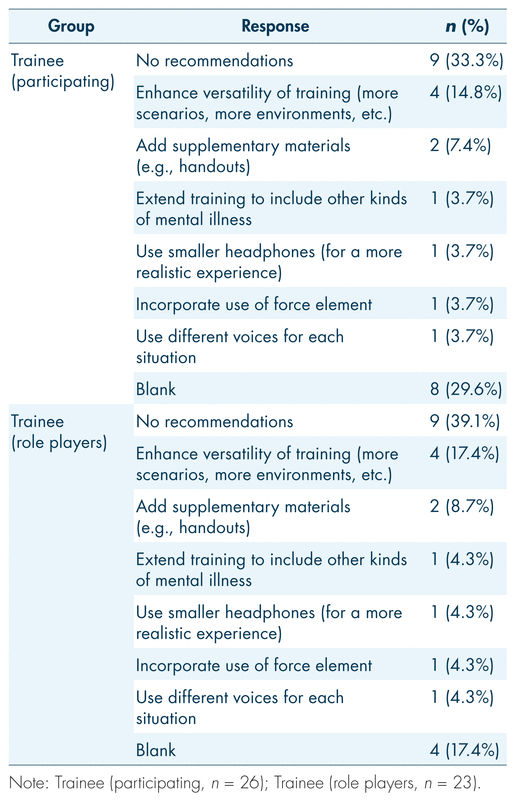
TABLE IV Suggestions for improvement to SV training—trainers
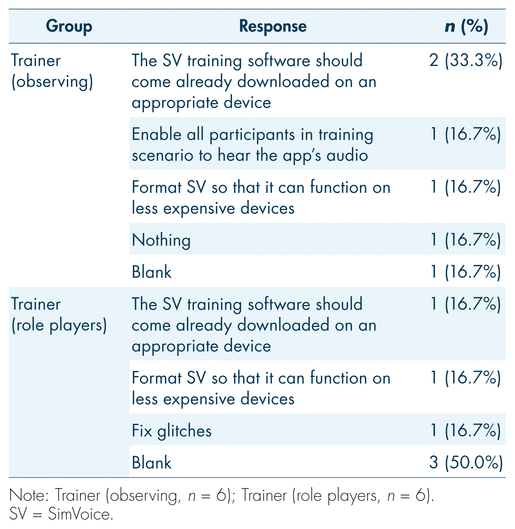
Given the frequency of interactions that occur between Canadian police officers and PMIs, there is a need for high-quality mental health training for officers to increase the likelihood of safe outcomes for all involved through the use of de-escalation strategies. Unfortunately, we currently know very little about the mental health or de-escalation training being offered by Canadian police services, and very few studies have been conducted which speak to the effectiveness of the training that is available (with some notable exceptions; e.g., see Krameddine et al., 2013). While only a first step in evaluating SV training, the current study adds to the small amount of Canadian research literature on this topic.
Findings from the current study suggest that SV can assist with the task of training police officers on how to peacefully resolve interactions with PMIs. Our survey results indicate that SV is a tool that is easy for police trainers to use and, in their eyes at least, it helps them present more realistic training to trainees by allowing role players to more accurately mimic the sorts of behaviours that might be exhibited by someone experiencing auditory hallucinations. In turn, this enables trainers to better meet their training objectives. In addition, respondents to our surveys indicated that SV training was very helpful for developing knowledge and skills known to be important for managing potentially volatile encounters, especially those involving PMIs (Bennell et al., 2022). This included, among other skills, various competencies related to the effective use of de-escalation, such as rapport building, remaining calm, active listening, and showing empathy.
In contrast to these views, SV training was perceived by some respondents as being less useful for developing other competencies, such as knowledge about when to transition from communication to use of force, and vice versa; arguably a critical skill for all officers. This issue likely results from the types of scenarios that the service under study currently uses when employing SV. Indeed, when asked about the limitations of SV, this was the most common issue raised by trainees—that SV training did not generalize well to other experiences in the field, especially those involving elements of danger that might require transitions from communication to the use of force. In theory, SV training could be easily adjusted to develop these (and other) relevant competencies by expanding the types of scenarios utilized in the training. So long as the training is appropriately structured and sequenced so that the added complexity does not significantly interfere with the learning process, stressful SV training scenarios could prove very useful (Bennell et al., 2021; Jenkins et al., 2021; Mugford et al., 2013).
Many of the limitations of SV that were raised by trainers were quite different from those raised by the trainees. For example, a number of limitations related to software and hardware issues, such as the fact that SV software did not always work on the device it was downloaded on. These limitations are critical, especially if they prevent SV training from being able to proceed. Even if workaround solutions can be found, the time wasted to find solutions is problematic given the serious time constraints that police trainers must contend with. The very limited in-service training time available for general duty police officers means that the time trainers do have with trainees must be free of tasks that distract them from their training; otherwise, their training goals are less likely to be met.
Few suggestions were made for how to improve SV training, presumably because trainers and trainees perceived it in such a positive light. Trainees did note that more versatile training scenarios and the addition of supplementary materials, such as informational handouts, would improve the training. Trainers suggested that SV software should already come downloaded on an appropriate device to avoid compatibility issues and that the software should be formatted for less expensive devices. It appears that all these improvements could be implemented in a relatively easy and cost-effective manner. Given this, we recommend that the participating police service and SetCan explore ways to make these changes.
The current study has several limitations. First, this study was conducted on small sub-samples of participants from only one police service. This means that results will not necessarily generalize to other officers within the service that was studied, or to police officers from outside the service. Researchers who examine SV in the future should attempt to conduct their research on larger samples of trainees and trainers from police services across Canada.
Second, participants self-selected to engage with this study, and we only included respondents if they fully completed the surveys. Both of these things could have biased the results. For example, trainees who enjoy taking part in SV training, and trainers who enjoy delivering SV training, may have been more likely to participate in the study and complete the surveys. This could have resulted in overestimates of how impactful SV training is. While the voluntary nature of research always makes this a challenging issue, greater care could be taken by researchers in the future to ensure that representative trainees and trainers are surveyed (e.g., by using multiple strategies for participant recruitment).
Finally, we focused on perceptions of SV training rather than the actual impact of this training. While it is promising that trainees and trainers involved in SV training felt that it allowed them to develop important skills, this does not necessarily mean that the training will have an impact on officer behaviour. Indeed, the field is full of training evaluations where attitudes and knowledge change because of training, but officer behaviour remains unaffected. To be sure that SV training is having the desired impact in the field, behavioural outcomes from SV trained and untrained officers will have to be examined using a more rigorous experimental design than was the case in the current study (e.g., a randomized control trial).
This study provides support for the use of SV as a tool for improving mental health de-escalation training. Both trainees and trainers involved in the training see it as having real value. While additional research is necessary before drawing strong conclusions about the impact that SV training will have on officers in the field, the results reported in this paper are promising. Thankfully, the fact that SV is freely available means that any service can use it; this should make the behaviourally-based research that we recommended above much easier to conduct.
We would like to thank Jeff Quail for his assistance with this project, Kyle Gallagher for his help with participant recruitment, and all the officers and trainers within the participating police service who took the time to complete our survey.
The authors declare that there are no conflicts of interest.
*Department of Psychology, Carleton University, ON, Canada..
Bennell, C., Jenkins, B., Blaskovits, B., Semple, T., Khanizadeh, A. J., Brown, A. S., Jones, N. J. (2022). Knowledge, skills, and abilities for managing potentially volatile police–public interactions: A narrative review. Frontiers in Psychology, 13. https://doi.org/10.3389/fpsyg.2022.818009
Crossref
Bennell, C., Blaskovits, B., Jenkins, B., Semple, T., Khanizadeh, A.-J., Brown, A., Jones, N. (2021). Promising practices for de-escalation and use-of-force training: A narrative review. Policing: An International Journal, 44, 377–404.
Crossref
Borum, R., Williams Deane, M., Steadman, H. J., Morrissey, J. (1998). Police perspectives on responding to mentally ill people in crisis: Perceptions of program effectiveness. Behavioral Sciences the Law, 16(4), 393–405. https://doi.org/10.1002/(SICI)1099-0798(199823)16:4393::AID-BSL3173.0.CO;2-4
Crossref
Boyce, J., Rotenberg, C., Karam, M. (2015). Mental health and contact with police in Canada, 2012. Statistics Canada. ISSN: 1209-6393.
Brink, J., Livingston, J., Desmarais, S., Greaves, C., Maxwell, V., Michalak, E., Parent, R., Verdun-Jones, S., Weaver, C. (2011). A study of how people with mental illness perceive and interact with the police. Mental Health Commission of Canada.
Coleman, T. G., Cotton, D. (2010). Reducing risk and improving outcomes of police interactions with people with mental illness. Journal of Police Crisis Negotiations, 10(1–2), 39–57. https://doi.org/10.1080/15332581003756950
Crossref
Geller, A., Fagan, J., Tyler, T., Link, B. G. (2014). Aggressive policing and the mental health of young urban men. American Journal of Public Health, 104(12), 2321–2327. https://doi.org/10.2105/AJPH.2014.302046
Crossref PubMed PMC
Jenkins, B., Semple, T., Bennell, C. (2021). An evidence-based approach to critical incident response scenario development. Policing: An International Journal, 44, 437–454.
Crossref
Kesic, D., Thomas, S., Ogloff, J. (2013). Use of nonfatal force on and by persons with apparent mental disorder in encounters with the police. Criminal Justice and Behavior, 40(3), 321–337. https://doi.org/10.1177/0093854812474425
Crossref
Krameddine, Y. I., Demarco, D., Hassel, R., Silverstone, P. H. (2013). A novel training program for police officers that improves interactions with mentally ill individuals and is cost-effective. Frontiers in Psychiatry, 4, 1–10. https://doi.org/10.3389/fpsyt.2013.00009
Crossref
Krippendorff, K. (2004). Content analysis: An introduction to its methodology (2nd ed.). Sage.
Lamanna, D., Shapiro, G. K., Kirst, M., Matheson, F. I., Nakhost, A., Stergiopoulos, V. (2018). Co-responding police–mental health programmes: Service user experiences and outcomes in a large urban centre. International Journal of Mental Health Nursing, 27(2), 891–900. https://doi.org/10.1111/inm.12384
Crossref
Mugford, R., Corey, S., Bennell, C. (2013). Improving police training from a cognitive load perspective. Policing: An International Journal of Police Strategies and Management, 36, 312–337.
Crossref
Nasser, S. (2021). No charges in death of Ejaz Choudry, 62-year-old shot and killed by police while in crisis. CBC News. https://www.cbc.ca/news/canada/toronto/ejaz-choudry-no-charges-siu-peel-police-1.5976266
Rossler, M. T., Terrill, W. (2017). Mental illness, police use of force, and citizen injury. Police Quarterly, 20(2), 189–212. https://doi.org/10.1177/1098611116681480
Crossref
Sellers, C. L., Sullivan, C. J., Veysey, B. M., Shane, J. M. (2005). Responding to persons with mental illnesses: Police perspectives on specialized and traditional practices. Behavioral Sciences the Law, 23(5), 647–657. https://doi.org/10.1002/bsl.633
Crossref PubMed
SetCan (n.d.). SimVoice. SetCan. http://www.setcan.com/simvoice.php
1Schizophrenia is a mental disorder that involves problems with cognition, behaviour, and emotions. Symptoms can include delusions (i.e., false beliefs), visual and auditory hallucinations, disorganized speech, and abnormal motor behaviour. ( Return to Text )
This work is licensed under the Creative Commons Attribution-NonCommercial-NoDerivatives 4.0 International License. To view a copy of this license, visit http://creativecommons.org/licenses/by-nc-nd/4.0/. For commercial re-use, please contact sales@sgpublishing.ca.
Journal of CSWB, VOLUME 7, NUMBER 4, December 2022